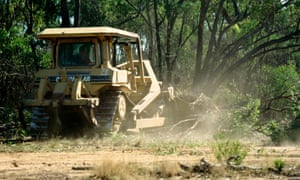Environment department ‘cherry picked’ data to claim clearing has decreased, but figures show recent steady increase
Two of Australia’s largest environment groups have accused the
federal environment department of providing inaccurate information about
land clearing to the Senate, and of not acting to reduce habitat loss.
The Australian Conservation Foundation and WWF Australia say the department has “cherry picked” data to claim that land clearing in Queensland has decreased, when national figures on land clearing rates in that state in fact show increases since 2011.
The groups say it highlights the need for an independent environmental protection authority, something the Labor party has promised if it wins the next federal election.
The department is sticking by its statements, first made to a hearing last year of the fauna extinctions inquiry that is currently before the Senate.
The department’s deputy secretary, Dean Knudson, told a hearing
“rates of land clearing have actually declined” nationally and “there’s
an absolute decline in clearing in Queensland”.The Australian Conservation Foundation and WWF Australia say the department has “cherry picked” data to claim that land clearing in Queensland has decreased, when national figures on land clearing rates in that state in fact show increases since 2011.
The groups say it highlights the need for an independent environmental protection authority, something the Labor party has promised if it wins the next federal election.
The department is sticking by its statements, first made to a hearing last year of the fauna extinctions inquiry that is currently before the Senate.
Annual clearing rates started increasing again after 2011 when state laws were wound back by the Newman government. New laws introduced by the Palaszczuk government aimed at curbing land clearing began to take effect only last year.
“Mr Knudson’s claims that ‘when we take a look at land clearing in the entire country, the rates of land clearing have actually declined’ and that ‘there’s an absolute decline in clearing in Queensland’ have both been proven conclusively false by the Federal Government’s own data and by the Queensland Government data,” they wrote.
The department replied, defending its statements.
There are two sources of land clearing data for Australia and Queensland.
National and state-by-state data is produced as part of Australia’s national emissions accounting system. The Queensland government also tracks land clearing through its Slats (statewide landcover and trees study) record-keeping system.
Numerous environment groups have pointed out inconsistencies between federal and state records.
The Queensland figure declined to 205,000 hectares by 2011, but climbed back up to 303,000 hectares in 2013 before falling slightly to 269,000 and 253,000 in 2014 and 2015 respectively, and increasing again to 301,000 in 2016.
The Slats data shows annual clearing rates increased every year in Queensland from 2009-10 until 2015-16, before decreasing slightly in 2016-17 and increasing again last year. The most recent summary listed combined primary and secondary clearing at 392,000 hectares in 2017-18.
“The fact is, tree clearing may have come down since the last decade but in Queensland it went up meteorically after the former Newman government took an axe to the laws,” said Martin Taylor, a conservation scientist at WWF Australia.
“To sit there and pretend it didn’t happen is dishonest.”
James Trezise, a policy analyst at the Australian Conservation Foundation, said the department’s response was disappointing.
“The data clearly shows land clearing exploded after the Newman government unpicked native vegetation laws in Queensland. Denying the facts undermines trust in our public institutions,” he said.
“The department has cherry picked data to support its narrative that land clearing in Queensland hasn’t been a significant issue for the past seven years.”
He said it was another example of how Australia’s environment laws were failing to protect threatened species and their habitat.
“This episode highlights why we need an independent federal EPA to provide frank and fearless advice on environmental issues,” he said.
But a spokesperson for the environment department said it “stands by its statements on land clearing”.
“The national dataset shows that clearing of primary forest (forests not observed to have been previously cleared) has experienced long-term decline since at least 2004-05,” the department said.
The department said its data showed primary clearing had fallen steadily in Queensland from 228,000 hectares to 35,000 hectares in 2014-15 and 36,000 hectares in 2015-16.
“The dataset also shows that clearing of secondary forests (forests that have been observed to have been previously cleared) in Queensland has declined somewhat since 2004-05 falling from 343,000 hectares in 2004-05 to 265,000 hectares in 2015-16,” it said.
The department said a forthcoming publication showed a large portion of this clearing was of vegetation that had been forest for “five years or less”.
“Over the last nine years, the area of land under emerging forest regrowth across Queensland has also grown quickly – on average by 308,000 hectares a year – which is in excess of the average rate of clearing.”

No comments:
Post a Comment